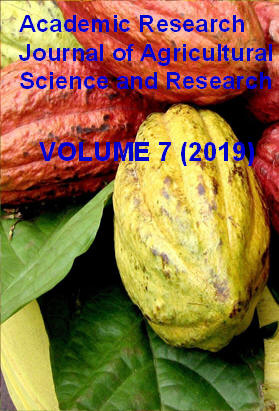|
ISSN: 2360-7874 |
Academic Research Journal of
Agricultural Science and Research |
|||||||||||||||||||
|
Vol. 7(7), pp. 530-538, November 2019 Research Effect of different source and rates of biochar application on the yield and yield components of mungbean on the acidic soil in western Ethiopia
Talila Garamu
Oromia Agriculture Research Institute (OARI) Sinana Agriculture Research Center P.O. Box 208, Bale Robe, Ethiopia (Email. talilagaram@gmail.com)
Accepted 11 November 2019
Mungbean is one of the most important food legume crops in Ethiopia. The yield of mungbean was reduced due to nutrient depletion and soil acidity. With this in view, effect of different source and rates of biochar application on the yield, and yield component of mungbean were studied. The treatments consists three source of biochar (maize, sesame and soybean source) and five rates of biochar (control, 2, 4, 6, 8, and 10 t ha−1) were laid out as a randomized complete block design in a factorial arrangement with three replications. The result showed that effects of biochar on the number of leaf per plant (17), number of branches( 5), number of seed per plant (14.6), 1000 seed weight (168g) and grain yield( 628.49 kg/ha) were significantly different at P<0.05. However days of flowering, days of maturity, plant height, pod length, number of pod per plant, biomass yield and Harvest index were statistically non-significant different at P<0.05. The results indicated that sesame sources at 10 t h-1 rates of biochar application gave the highest grain yield. In contrast, the lowest grain yield (513.4 kg ha-1) was recorded from control treatment, although the interaction effects of different source and rates of biochar application were significant on munbean varieties. The future studies should articulate towards the studies involving more varieties, multi-location and additional different source and rates of biochar applications, under diverse management practices such as research and farmer’s field’s conditions.
Key words; Biochar, Local variety, acidic soil and Grain yield.
How to cite this article (APA Style): Talila G (2019). Effect of different source and rates of biochar application on the yield and yield components of mungbean on the acidic soil in western Ethiopia. Acad. Res. J. Agri. Sci. Res. 7(7): 530-538
|
|||||||||||||||||||
